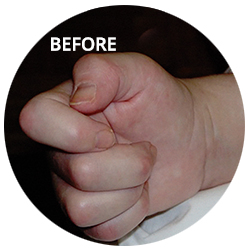Since ancient times in China, it has been accepted practice to needle “Ashi” points (pronounced “aw-shee”), which are tender points, not on acupuncture meridian lines. Not surprisingly, they have also been called “ouch” points in English, because tenderness is pain provoked by touching. When Ashi points are needled with acupuncture needles, pain often disappears, or at least improves. These needles are well-suited to the task, since they are very thin, solid, flexible, made from stainless steel, available sterilized and packaged for single use. Unlike hypodermic needles, which have a sharp cutting edge, acupuncture needles are both sharp and rounded at the tip, allowing them to slide through tissues without creating damage. A good analogy is the insertion of a knitting needle into a ball of wool without damaging the wool.
Ashi points are usually in muscle and tender to the touch.1 There is almost always a palpable “knot” in the muscle corresponding to the tender point. Using our knowledge of anatomy to determine the safest direction to insert a needle into the TrP, we can needle it briefly to decrease pain and increase range of motion. Yes, it can happen that fast, but usually several treatments are needed to get cumulative effects with long-lasting results.
Dr. C. Chan Gunn of Vancouver, developed what he called Intramuscular Stimulation (IMS) when he worked at the Worker’s Compensation Board of BC in the 1970s. I first heard him lecture in Vancouver in 1976 and was impressed with his theory of the roles that nerve and muscle play in the production of chronic pain that could not be otherwise explained. You can read about IMS at http://www.istop.org/education.html.


In a nutshell, Dr. Gunn makes the case that a lot of chronic pain is caused by shortened muscles following an injury or, for example, the sudden overloading of a muscle to prevent a fall when slipping on ice. The problem could also arise because of having a short leg, which requires muscles in the buttock on one side to work overtime; or it could happen after a spinal cord injury, related to muscle weakness and spasticity.
Dr. Gunn’s theory is based on a fundamental “law” of neurophysiology called Cannon and Rosenbleuth’s law of denervation: “When a unit is destroyed, in a series of efferent neurons, an increased irritability to chemical agents develops in the isolated structure or structures, the effect being maximal in the part directly denervated.2” In simple terms, this means that when a nerve to a tissue (let’s say, a muscle) is destroyed or injured (denervation), the tissue the nerve supplies becomes sensitive to various chemicals, many of which are produced by our own bodies. The result is a tight muscle tugging on a nerve that is damaged in the process, resulting in the muscle becoming supersensitive. When you search for a tender point to massage when you have a pain in your neck, you are seeking a muscle that fits this description. Pressure on it can often relieve your symptoms.
When Dr. Gunn published a book in 1996 about his explanation for the existence of chronic pain which appeared to have no cause, his use of the term “neuropathic” to define the pain seemed logical. At the time, “neuropathic pain” to describe pain caused by a nerve injury had not become widely used. While his theory makes sense, the terminology is a bit confusing.
How does this concept relate to SCI pains and dysfunction?
Understanding that tight muscles can restrict range of motion can be likened to tight reins on a horse. It sounds odd, but a case from the early days of our using acupuncture at Lyndhurst in 1992 defined this concept for me.
Our patient was a woman with incomplete quadriplegia in the early weeks after her injury. The degree of recovery she was going to have was not yet fully evident. We were able to help her pain, but she was worried that she could not grip with her right hand. We assumed that weakness of her flexor muscles due to the SCI prevented her from flexing her fingers enough to grasp anything smaller than a tennis ball. She despaired of ever regaining the use of her hand.
I palpated the extensor muscles on the back of her forearm and found taut bands of muscle that were tender. After telling her that what I was going to do might hurt, I inserted an acupuncture needle into the tight muscles and after I did that several times, she successfully attempted to make a fist with her hand, then burst into tears of joy.
The problem wasn’t that she had lost the function of the hand; the tight muscles were restricting function that was intact. It was as though her fingers were being held back by tight reins. If one has the opposite problem of not being able to open their hand, needling the flexor muscles on the palmar surface of the forearm can assist in relaxing them to allow the fingers to extend enough to open the hand. Photos A and B show the hand of a patient who had spasticity after a cervical spine injury. The tight fist seen in A was reduced by IMS on the flexor muscles along with manual stretching of them. The result after a few treatments is seen in photo B.
I speak with personal experience when I admit that dry needling can be painful. However, I also speak with personal experience when I say that the relief of pain it can reliably bring, when muscle is the source, is nothing short of astonishing.
Dry needling alone does not produce all the beneficial effects that acupuncture itself offers, such as relaxation and improvement in mood, but it can relieve pain and increase range of movement. It is a very useful tool in our “toolbox”.
1 https://www.sciencedirect.com/science/article/pii/S100352571730003X
2 Adams RD, Victor M. Book: Principles of Neurology 1981, McGraw-Hill Book Company, p. 374.






